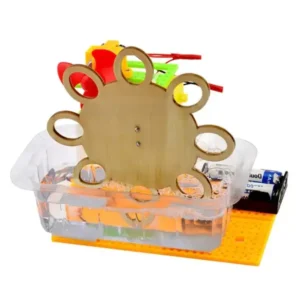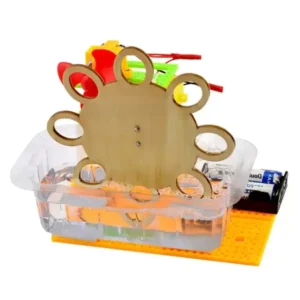Traffic light – Energy transformation – Electric energy to light energy conversion
29,00 AED
Traffic lights play a pivotal role in regulating the flow of vehicles and pedestrians at intersections. These ubiquitous devices undergo a fascinating energy transformation process to function effectively. At the heart of this process is the conversion of electric energy into light energy.

Product Details
Reviews
Product Details
Objective:
Demonstrate a model of a Traffic Light to illustrate the conversion of electric energy into light energy for traffic control
Materials included:
Three Color Lights
Connecting Wires
Batteries
Plastic Stand
Materials not included in the kit:
Procedure and assembly steps:
Procedure included in the kit manual . This is not a ready made product. Student needs to follow the steps to assemble the model…
Description:
Traffic Light: Converting Electric Energy into Light
Traffic lights play a pivotal role in regulating the flow of vehicles and pedestrians at intersections. These ubiquitous devices undergo a fascinating energy transformation process to function effectively. At the heart of this process is the conversion of electric energy into light energy. Let’s explore how this transformation occurs in a traffic light.
- Electric Energy Source:
- A traffic light operates by drawing electric energy from a power source, typically from the electrical grid. This electric energy serves as the starting point for the energy transformations within the traffic light.
- Light Emitting Diodes (LEDs):
- Inside the traffic light, there are Light Emitting Diodes (LEDs) designed to efficiently convert electrical energy into visible light. LEDs are the primary components responsible for the transformation of energy in a traffic light.
- Conversion Process:
- When electric current flows through the circuitry of the traffic light, it encounters the LEDs. These LEDs are specifically engineered to transform electrical energy into light energy efficiently.
- Photon Emission:
- The energy transformation occurs at the atomic level within the LEDs. As electrons flow through the semiconductor material of the LEDs, they combine with positively charged “holes,” releasing energy in the form of photons. Photons are packets of light energy.
- Illumination of Signals:
- The released photons, in the form of visible light, are responsible for illuminating the red, yellow, or green signals in the traffic light. This light emission is what makes the traffic light signals visible to drivers and pedestrians.
- Energy Efficiency and Environmental Benefits:
- This conversion of electric energy into light energy using LEDs is highly efficient and results in bright and clearly visible traffic signals. It is also environmentally friendly, as it conserves energy compared to traditional incandescent bulbs, contributing to energy savings and reducing environmental impact.
Learning outcome:
Have a better understanding of a Traffic Light to illustrate the conversion of electric energy into light energy for traffic control using the model built by the student in this project
Section or subject:
Physics
Grades:
6+
Reviews
Be the first to review “Traffic light – Energy transformation – Electric energy to light energy conversion” Cancel reply
















Reviews
There are no reviews yet.